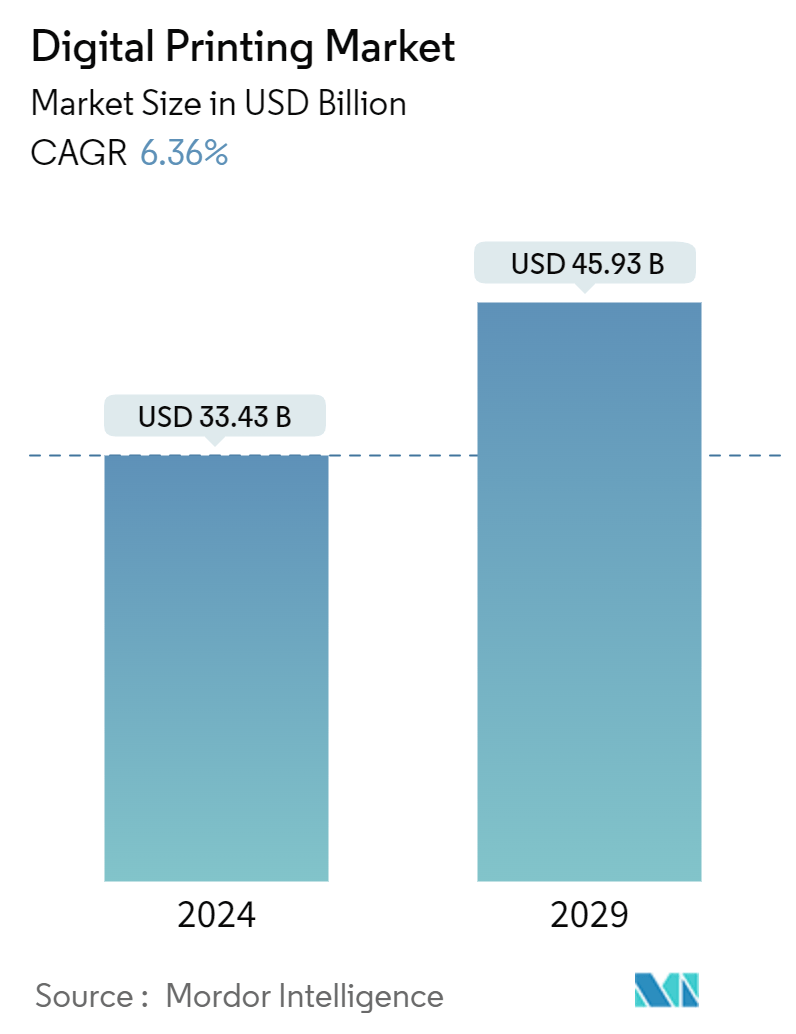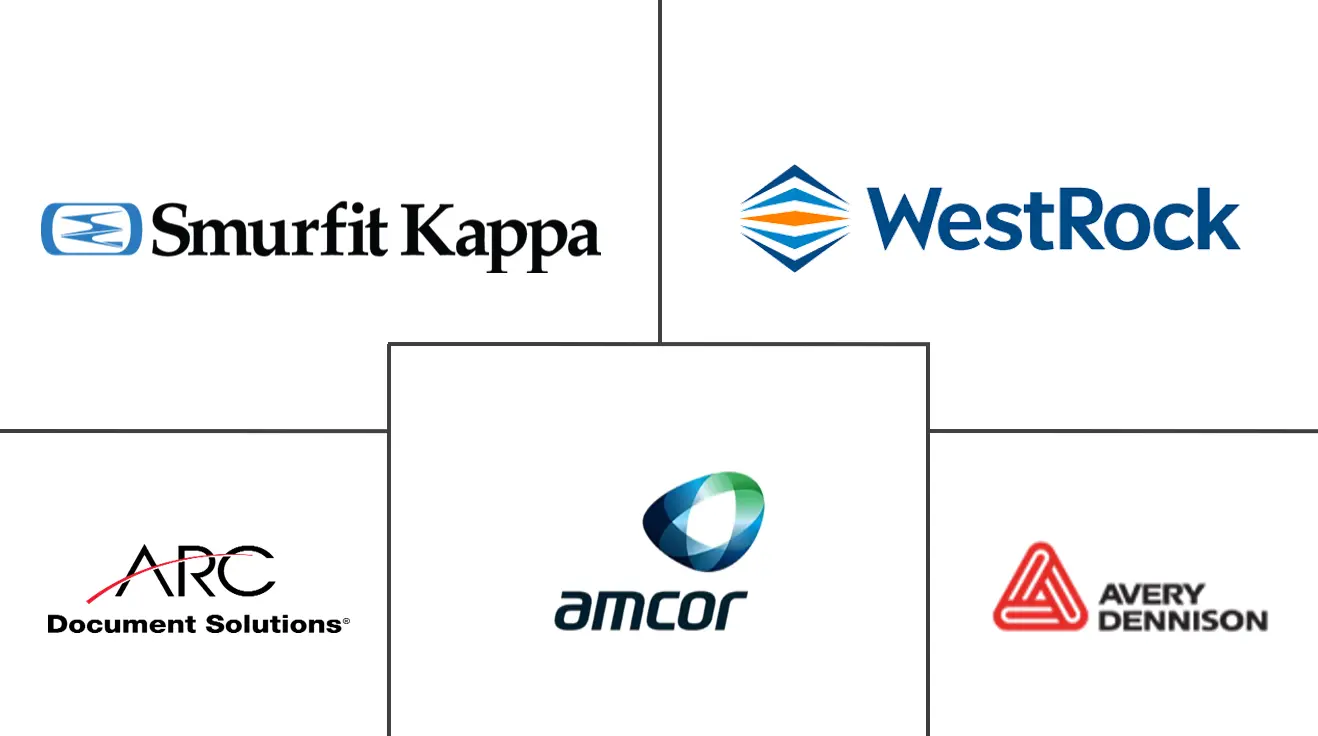Market Size of Digital Printing Industry

| Study Period | 2019 - 2029 |
| Market Size (2024) | USD 33.43 Billion |
| Market Size (2029) | USD 45.93 Billion |
| CAGR (2024 - 2029) | 6.36 % |
| Fastest Growing Market | Asia Pacific |
| Largest Market | North America |
| Market Concentration | Low |
Major Players
*Disclaimer: Major Players sorted in no particular order |
Digital Printing Market Analysis
The Digital Printing Market size is estimated at USD 33.43 billion in 2024, and is expected to reach USD 45.93 billion by 2029, growing at a CAGR of 6.36% during the forecast period (2024-2029).
Digital printing is a process of printing using technologies onto various media substrates. Digital printing is more accurate and cost-effective than conventional printing processes. The need for high-quality, cost-effective graphics and environmental sustainability is anticipated to drive awareness toward digital printing.
- Significant improvements in print manufacturing include efficiency, with just-in-time production and a growing focus on supply chain management, which have reduced wastage in the print market. Technological developments aiding digital printing have guaranteed waste minimization, keeping the print quality at par.
- Advanced digital printing technology includes mild solvents and less harmful chemicals than conventional printing technologies, such as solid ink printing and offset printing. Hence, the demand for digital printing solutions is increasing in the printed electronics market, increasing the focus on green printing and cost-effective production.
- Commercial printing is witnessing transitional and structural changes as a significant application, as the immediate transition from conventional methods of print to digital is challenging. The printing cost is expected to take a toll since it is still a niche method requiring print of shorter/customized batches.
- Moreover, with the rise of retail businesses such as supermarkets, hypermarkets, and e-commerce, there is an increasing demand for personalized and customized printed products. Digital printing technology allows firms to produce small batches or even individualized items cost-effectively, catering to niche markets and customized customer choices.
- The latest advancements, such as AI, machine learning, IoT, and data analytics, have personalized offerings to a significant extent. The convergence in digital printing enables superiority in print personalization for large-volume orders. However, the cost factor remains a big hurdle. Additionally, high-priced investments for inks or equipment, maintenance, installation fees, and other consumables might limit the market's growth.
Digital Printing Industry Segmentation
Digital printing is a process that incorporates on-demand, high-quality print. It represents a modern production technique that enables printing from electronic files. Furthermore, it does not need a printing plate, unlike the more conventional offset printing. The study tracks the revenue accrued from the various digital printing processes that are being used across various applications. Also, the revenue accrued from the digital printing vendors has been considered.
The Digital Printing Market is Segmented by Printing Process (Electrophotography and Inkjet), Application (Books, Commercial Printing, and Packaging [Labels, Corrugated Packaging, Cartons, Flexible Packaging, Rigid Plastic Packaging, and Metal Packaging]), and Geography (North America [United States and Canada], Europe [Germany, United Kingdom, France, Netherlands, Poland, and Rest of Europe], Asia-Pacific [China, India, Japan, and Rest of Asia-Pacific], Latin America [Brazil, Mexico, and Rest of Latin America], and Middle East and Africa [United Arab Emirates, Saudi Arabia, Egypt, South Africa, and Rest of Middle East and Africa]). The market sizes and forecasts are provided in terms of value (USD) for all the above segments.
| By Printing Process | |
| Electrophotography | |
| Inkjet |
| By Application | ||||||||
| Books | ||||||||
| Commercial Printing | ||||||||
|
| By Geography*** | |||||||||
| |||||||||
| |||||||||
| |||||||||
| |||||||||
|
Digital Printing Market Size Summary
The digital printing market is experiencing robust growth, driven by advancements in technology and increasing demand for efficient, high-quality printing solutions. This sector is rapidly evolving, with digital printing becoming a significant component of the sign industry due to its ability to produce large-scale prints with precision. The shift from traditional printing methods to digital solutions is facilitated by improvements in manufacturing efficiency and supply chain management, which have significantly reduced waste. The adoption of digital printing is further bolstered by its environmentally friendly attributes, such as the use of mild solvents and less harmful chemicals compared to conventional methods. This trend is particularly evident in the packaging industry, where digital printing technologies are being integrated into various packaging methods to meet specific branding and product demands.
The market landscape is characterized by intense competition, with major players investing in technological innovations and strategic partnerships to enhance their market presence. Companies are increasingly adopting digital presses to improve production capacity and meet the growing demand for personalized and variable data printing. The packaging sector, including corrugated boxes, flexible packaging, and rigid plastic packaging, is a key area of growth, with digital printing offering significant advantages in terms of speed, efficiency, and customization. Despite the high initial investment costs associated with digital printing technologies, the market is poised for substantial growth, supported by ongoing advancements and the increasing adoption of digital solutions across various industries.
Digital Printing Market Size - Table of Contents
-
1. MARKET INSIGHTS
-
1.1 Market Overview
-
1.2 Industry Attractiveness - Porter's Five Forces Analysis
-
1.2.1 Bargaining Power of Suppliers
-
1.2.2 Bargaining Power of Buyers
-
1.2.3 Threat of New Entrants
-
1.2.4 Threat of Substitute Products
-
1.2.5 Intensity of Competitive Rivalry
-
-
1.3 Technology Snapshot
-
-
2. MARKET SEGMENTATION
-
2.1 By Printing Process
-
2.1.1 Electrophotography
-
2.1.2 Inkjet
-
-
2.2 By Application
-
2.2.1 Books
-
2.2.2 Commercial Printing
-
2.2.3 Packaging
-
2.2.3.1 Labels
-
2.2.3.2 Corrugated Packaging
-
2.2.3.3 Cartons
-
2.2.3.4 Flexible Packaging
-
2.2.3.5 Rigid Plastic Packaging
-
2.2.3.6 Metal Packaging
-
-
-
2.3 By Geography***
-
2.3.1 North America
-
2.3.1.1 United States
-
2.3.1.2 Canada
-
-
2.3.2 Europe
-
2.3.2.1 United Kingdom
-
2.3.2.2 Germany
-
2.3.2.3 France
-
2.3.2.4 Italy
-
2.3.2.5 Spain
-
2.3.2.6 Netherlands
-
2.3.2.7 Poland
-
-
2.3.3 Asia
-
2.3.3.1 China
-
2.3.3.2 India
-
2.3.3.3 Japan
-
2.3.3.4 Australia and New Zealand
-
-
2.3.4 Latin America
-
2.3.4.1 Brazil
-
2.3.4.2 Mexico
-
-
2.3.5 Middle East and Africa
-
2.3.5.1 United Arab Emirates
-
2.3.5.2 South Africa
-
2.3.5.3 Saudi Arabia
-
2.3.5.4 Egypt
-
-
-
Digital Printing Market Size FAQs
How big is the Digital Printing Market?
The Digital Printing Market size is expected to reach USD 33.43 billion in 2024 and grow at a CAGR of 6.36% to reach USD 45.93 billion by 2029.
What is the current Digital Printing Market size?
In 2024, the Digital Printing Market size is expected to reach USD 33.43 billion.

